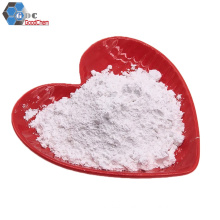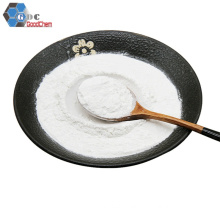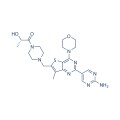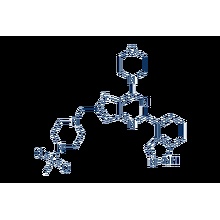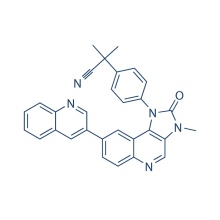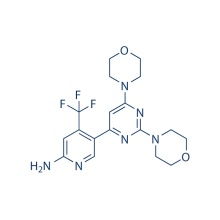.cp_wz tabla {borde superior: 1px sólido #ccc; borde izquierdo: 1px sólido #ccc; } .cp_wz table td {borde derecho: 1px sólido #ccc; borde inferior: 1px sólido #ccc; padding: 5px 0px 0px 5px;} .cp_wz table th {border-right: 1px solid #ccc; border-bottom: 1px solid #ccc; relleno: 5px 0px 0px 5px;} \ n Peso molecular: 498.6 Apitolisib (GDC-0980, RG7422) es un potente inhibidor de PI3K de clase I para PI3Kα / β / δ / γ con IC50 de 5 nM / 27 nM / 7 nM / 14 nM, respectivamente. También es un inhibidor de mTOR con Ki de 17 nM y muy selectivo frente a otras quinasas de la familia PIKK. Fase 2. \ n GDC-0980 muestra las potentes y selectivas actividades inhibidoras contra la quinasa PI3K y mTOR de clase I frente a un gran panel de quinasas con Ki de 17 nM para mTOR e IC50 de 5 nM, 27 nM, 7 nM y 14 nM para PI3Kα, β, δ y γ, respectivamente. In vitro, GDC-0980 inhibe significativamente la proliferación celular en células PC3 y MCF7 con IC50 de 307 nM y 255 nM, respectivamente. Un estudio reciente muestra que GDC-0980 reduce la viabilidad de las células cancerosas al inhibir el proceso del ciclo celular e inducir la apoptosis con mayor potencia en la próstata (IC50 \ n en los modelos de xenoinjerto PC-3 y MCF-7 neo / HER2, GDC-0980 en un dosis de 1 mg / kg, muestra una actividad antitumoral significativa al provocar un retraso en el crecimiento del tumor. Además, GDC-0980 produce estasis o regresiones tumorales a la dosis máxima tolerada de 7,5 mg / kg. [1] En ratones, la administración intravenosa de GDC-0980 a 1 mg / kg conduce a un aclaramiento bajo (Clp: 9,2 ml / min / kg, Vss: 1,7 L / kg). Mientras que, la administración oral a 5 mg / kg en PEG400 al 80% y a 50 mg / kg como suspensión cristalina en 0,5% de metilcelulosa / 0,2% de Tween-80 también da como resultado parámetros farmacocinéticos favorables. Un inhibidor potente, selectivo y disponible por vía oral de PI3Kα, β, δ, γ y mTOR. Protocolo (solo como referencia) Ensayo de quinasa: [1]
|
Enzymatic activity
|
Enzymatic activity of the Class I PI3K isoforms is measured using a fluorescence polarization assay that monitors formation of the product 3,4,5-inositoltriphosphate molecule as it competes with fluorescently labeled PIP3 for binding to the GRP-1 pleckstrin homology domain protein. An increase in phosphatidyl inositide-3-phosphate product results in a decrease in fluorescence polarization signal as the labeled fluorophore is displaced from the GRP-1 protein binding site. Class I PI3K isoforms are expressed and purified as heterodimeric recombinant proteins. PI3K isoforms are assayed under initial rate conditions in the presence of 10 mM Tris (pH 7.5), 25 μM ATP, 9.75 μM PIP2, 5% glycerol, 4 mM MgCl2, 50 mM NaCl, 0.05% (v/v) Chaps, 1 mM dithiothreitol, 2% (v/v) DMSO at the following concentrations for each isoform: PI3Kα,β at 60 ng/mL; PI3Kγ at 8 ng/mL; PI3Kδ at 45 ng/mL. After assay for 30 minutes at 25°C, reactions are terminated with a final concentration of 9 mM EDTA, 4.5 nM TAMRA-PIP3, and 4.2 μg/mL GRP-1 detector protein before reading fluorescence polarization on an Envision plate reader. IC50s are calculated from the fit of the dose−response curves to a 4-parameter equation.Human recombinant mTOR(1360−2549) is expressed and purified from insect cells and assayed using a Lanthascreen fluorescence resonance energy transfer format in which phosphorylation of recombinant green fluorescent protein (GFP)-4-EBP1 is detected using a terbium-labeled antibody to phospho-threonine 37/46 of 4-EBP1. Reactions are initiated with ATP and conducted in the presence of 50 mM Hepes (pH 7.5), 0.25 nM mTOR, 400 nM GFP-4E-BP1, 8 μM ATP, 0.01% (v/v) Tween 20, 10 mM MnCl2, 1 mM EGTA, 1 mM dithiothreitol, and 1% (v/v) DMSO. Assays are conducted under initial rate conditions at room temperature for 30 minutes before terminating the reaction and detecting product in the presence of 2 nM Tb-anti-p4E-BP1 antibody and 10 mM EDTA. Dose−response curves are fit to an equation for competitive tight-binding inhibition and apparent Ki' s are calculated using the determined Km for ATP of 6.1 μM.
|
Ensayo celular: [1]
|
Cell lines
|
PC3 and MCF7.1
|
|
Concentrations
|
0 to 10 μM
|
|
Incubation Time
|
72 hours or 96 hours
|
|
Method
|
Antiproliferative cellular assays are conducted using PC3 and MCF7.1 human tumor cell lines. MCF7.1 is an in vivo selected line and originally derived from the parental human MCF7 breast cancer cell line. Cell lines are cultured in RPMI supplemented with 10% fetal bovine serum, 100 units/mL penicillin, and 100 μg/mL streptomycin, 10 mM HEPES, and 2 mM glutamine at 3°C under 5% CO2. MCF7.1 cells or PC3 cells are seeded in 384-well plates in media at 1000 cells/well or 3000 cells/well, respectively, and incubated overnight prior to the addition of GDC-0980 to a final DMSO concentration of 0.5% v/v. MCF7.1 cells and PC3 cells are incubated for 3 days and 4 days, respectively, prior to the addition of CellTiter-Glo reagen and reading of luminescence using an Analyst plate reader. For antiproliferative assays, a cytostatic agent such as aphidicolin and a cytotoxic agent such as staurosporine are included as controls. Dose−response curves are fit to a 4-parameter equation and relative IC50s are calculated using Assay Explorer software.
|
Estudio con animales: [1]
|
Animal Models
|
PC3 and MCF7.1 cells are injected s.c. into the right hind flank of athymic nu/nu (nude) mice.
|
|
Formulation
|
GDC-0980 is dissolved in 0.5% methylcellulose with 0.2% Tween-80 (MCT).
|
|
Dosages
|
≤7.5 mg/kg
|
|
Administration
|
Administered via p.o.
|
|
Solubility
|
0.5% methylcellulose/0.2% Tween 80,
30 mg/mL
|
|
* Please note that Selleck tests the solubility of all compounds in-house, and the actual solubility may differ slightly from published values. This is normal and is due to slight batch-to-batch variations.
|
Conversión de diferentes modelos de animales basados en BSA (valor basado en datos del Borrador de Directrices de la FDA)
|
Species
|
Baboon
|
Dog
|
Monkey
|
Rabbit
|
Guinea pig
|
Rat
|
Hamster
|
Mouse
|
|
Weight (kg)
|
12
|
10
|
3
|
1.8
|
0.4
|
0.15
|
0.08
|
0.02
|
|
Body Surface Area (m2)
|
0.6
|
0.5
|
0.24
|
0.15
|
0.05
|
0.025
|
0.02
|
0.007
|
|
Km factor
|
20
|
20
|
12
|
12
|
8
|
6
|
5
|
3
|
|
Animal A (mg/kg) = Animal B (mg/kg) multiplied by
|
Animal B Km
|
|
Animal A Km
|
Por ejemplo, para modificar la dosis de resveratrol utilizada para un ratón (22,4 mg / kg) a una dosis basada en el BSA para una rata, multiplique 22,4 mg / kg por el factor Km para un ratón y luego divida por el factor Km para una rata. Este cálculo da como resultado una dosis equivalente para ratas de resveratrol de 11,2 mg / kg.
|
Rat dose (mg/kg) = mouse dose (22.4 mg/kg) ×
|
mouse Km(3)
|
= 11.2 mg/kg
|
|
rat Km(6)
|
Información química
|
Molecular Weight (MW)
|
498.6
|
|
Formula
|
C23H30N8O3S
|
|
CAS No.
|
1032754-93-0
|
|
Storage
|
3 years -20℃Powder
|
|
6 months-80℃in solvent (DMSO, water, etc.)
|
|
Synonyms
|
|
|
Solubility (25°C) *
|
In vitro
|
DMSO
|
20 mg/mL
(40.11 mM)
|
|
Water
|
<1 mg/mL
(
|
|
Ethanol
|
<1 mg/mL
(
|
|
In vivo
|
0.5% methylcellulose/0.2% Tween 80
|
30 mg/mL
|
* <1 mg/ml means slightly soluble or insoluble.
* Please note that Selleck tests the solubility of all compounds in-house, and the actual solubility may differ slightly from published values. This is normal and is due to slight batch-to-batch variations.
|
|
Chemical Name
|
(S)-1-(4-((2-(2-aminopyrimidin-5-yl)-7-methyl-4-morpholinothieno[3,2-d]pyrimidin-6-yl)methyl)piperazin-1-yl)-2-hydroxypropan-1-one
|
Calculadora de molaridad Calculadora de dilución Calculadora de peso molecular
Grupos de Producto : PI3K / Akt / mTOR > Inhibidor de PI3K

